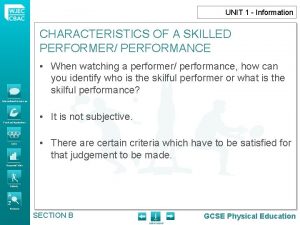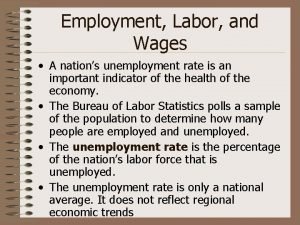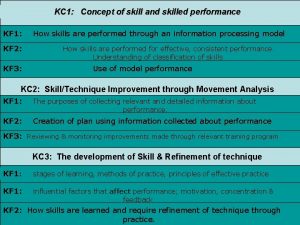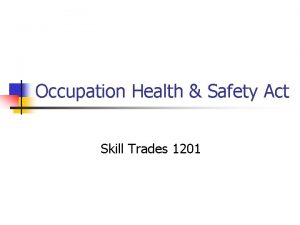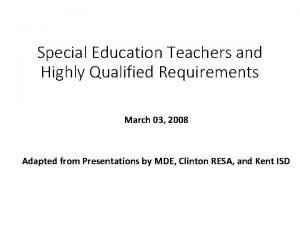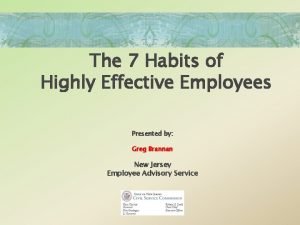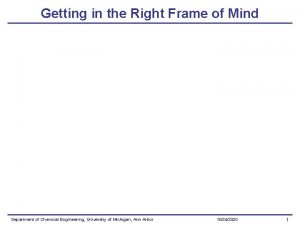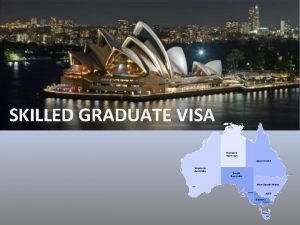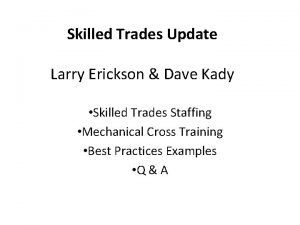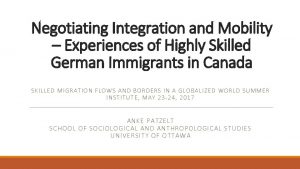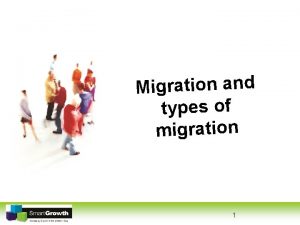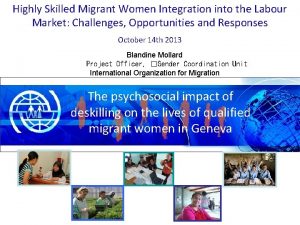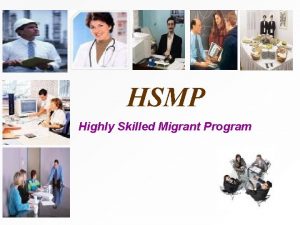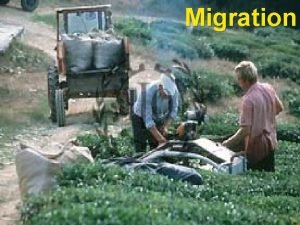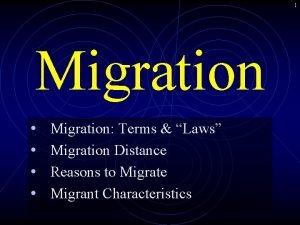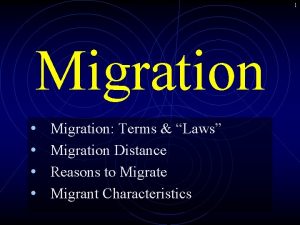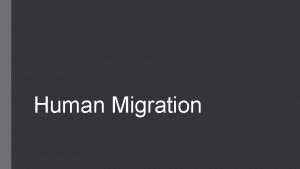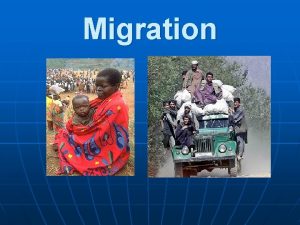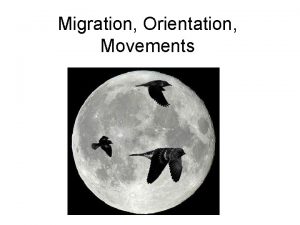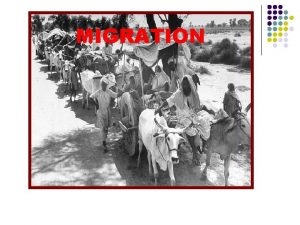Highly Skilled Migration to the EU and the

































- Slides: 33

Highly Skilled Migration to the EU and the EU Blue Card Directive WUN Migration Conference 2016 Lieven Brouwers DG Migration and Home Affairs European Commission

• What is the EU Blue Card? • Public consultation on the EU Blue Card and the EU’s labour migration policies • Why does the EU need (highly skilled) labour migration? • How is the EU doing in the global race for talent? • Why is the EU underperforming? • How to address this?

What is the EU Blue Card?

The EU Blue Card Council Directive 2009/50/EC on the conditions of entry and residence of third-country nationals for the purposes of highly qualified employment Scope: • Applicable in 25 Member States (not in UK, DK, IE) • Third-country nationals (TCN) = non-EU citizens • "Highly qualified workers" • Paid employees Purpose: • Improve attractiveness of EU • Facilitate admission and mobility • Harmonise entry and residence conditions • Simplify admission procedures • Improve legal status Entry into force: • Adopted 25 May 2009 • Transposition deadline 19 June 2011 • Majority of MS transposed in 2012, only in 2013 all 25

Main entry conditions: • Work contract or binding job offer (min. 1 year) • Minimum salary threshold • Higher professional qualifications Rights of Blue Card holders and their families: • Enter, re-enter and stay in issuing Member State • Allowed to work in the sector concerned in issuing Member State • Allowed to travel through other Member States (Schengen mobility) • Equal treatment with nationals on certain social rights • Facilitation for family reunification • Facilitation for Long-Term Resident status • After 18 months, some facilitation for moving to another Member State upon fulfillment of conditions ("intra-EU mobility”)

The EU Blue Card as a political priority Junker's Political Guidelines (July 2014) "I want Europe to become at least as attractive as the favourite migration destinations such as Australia, Canada and the USA. As a first step, I intend to review the “Blue Card” legislation and its unsatisfactory state of implementation. ” European Agenda on migration (May 2015) "A review of the Directive will look at how to make it more effective in attracting talent to Europe. The review will include looking at issues of scope such as covering entrepreneurs who are willing to invest in Europe, or improving the possibilities for intra EU mobility for Blue Card holders. ” "Key Action Modernisation and overhaul of the Blue Card scheme. " •

The EU Blue Card Public consultation on the EU Blue Card and the EU’s labour migration policies How: • Online open public consultation • Timing: 27 May – 30 Sept 2015 • Target audience: broadest public possible • Online, in all official EU languages • Dissemination: as widely as possible, using various communication channels Purpose: • Collect opinions on a range of issues related to economic migration • Gather opinions on how the shortcomings of the EU Blue Card scheme can best be addressed, and how it can be made more effective and attractive

The EU Blue Card Results: Total: 625 Online survey: 610 Written contributions: 15 Publication on 6 April 2016 Respondents by category:

Why does the EU need (highly skilled) labour migration?

Why does the EU need (highly skilled) labour migration? The EU’s current and future challenges: • • Demographic projections for the next decades o Rapidly ageing EU population o Progressively shrinking labour force o Increasing old-age dependency ratio Current and future skills shortages in key sectors of the EU economy o Cannot be filled by existing EU workforce despite high unemployment o Labour mobility of the EU domestic workforce insufficient o Potentially limits growth, productivity, innovation, economic recovery and competitiveness o Shortages projected to increase, especially in highly skilled sector

Why does the EU need (highly skilled) labour migration? Top 10 bottleneck vacancies at European level (ISCO 2 -digit level)

Why does the EU need (highly skilled) labour migration? Future shortages in EU? Large changes in labour demand by level of qualification projected over 2012 -25 (CEDEFOP) (in millions): 2012 2025 Change in % Low 49 37 -11. 5 -23. 7 Medium 108 111 3. 7 3. 4 High 68 83 15. 3 22. 7 Examples of sector-specific projected future shortages ICT professionals: By 2020: 756. 000 unfilled vacancies for highly skilled ICT professionals, or around 130. 000 vacancies per year Healthcare professionals: By 2020: shortfall of around 1 million highly skilled healthcare workers

Why does the EU need (highly skilled) labour migration? Is it necessary to recruit non-EU migrant workers to address labour shortages? Profile 1: Employers, Employers' Associations , Managers 76 Profile 2: Private/Public Employment Services, Trade Unions 31 Profile 3: NGOs, National/Regional/Local Authorities, Embassies 52 Profile 4: Media, Academia, NGOs, IOs, Countries of Origin, Individuals 283 Profile 5: Non-EU migrant workers residing inside the EU 76 Profile 6: Potential non-Eu migrant workers residing outside the EU 92

How is the EU doing in the global race for talent?

How is the EU doing in the global race for talent? The global supply and demand for highly skilled workers: • • Supply side: o Since 1990 s: increasing flows form Asia to major OECD countries and increasing exchange of skilled workers between developed countries o Progressively growing global talent pool o Diminishing share of OECD countries in the global talent pool Demand side: o Demand for HSW in “knowledge economy” expected to continue to grow o Not only in high-income countries, also increasingly in medium-income countries. o Increasing global competition between growing number of economies o Global labour markets likely to absorb increasing supply

How is the EU doing in the global race for talent? The EU’s attractiveness gap: • • High attractiveness of EU o Relatively strong attractiveness for highly educated potential migrants o High ratings on factors of attractiveness (attractiveness = multifaceted) Relatively low numbers of HSW o Low numbers of HSW attracted to EU o Low retention rates of talent

How is the EU doing in the global race for talent? How would you rate the attractiveness of the EU on the following factors ? Profile 1: Employer, Employers' Association , Manager 76 Profile 2: Private/Public Employment Service, Trade Union 31 Profile 3: NGO, National/Regional/Local Authoritie, Embassy 52 Profile 4: Media, Academia, NGO, IO, Country of Origin, Individual 283 Profile 5: Non-EU migrant worker residing inside the EU 76 Profile 6: Potential non-Eu migrant worker residing outside the EU 92

How is the EU doing in the global race for talent? Statistics on the EU Blue Card and national HSW schemes

How is the EU doing in the global race for talent? Comparison Blue Cards & National HSW schemes Blue Cards 2013 2014 National Blue Cards schemes EU 28 33321 32458 35530 EU 25 3 664 19 755 12 964 21 940 13 852 24 916 BE 0 95 5 73 19 2484 BG 15 0 14 0 21 0 CZ 62 not applicable 2584 69 72 not applicable 11580 69 104 46 5730 0 5698 11 DK DE 4088 12108 13 0 15 0 1707 0 2438 0 12 not applicable n. y. a. 0 na 0 1231 313 1480 39 2137 3037 371 2667 597 2561 n. y. a. 10 565 7 0 1695 87 1543 165 1066 600 0 385 0 469 106 10 82 32 122 0 26 0 92 0 LU 17 in force: 2013 183 21 236 0 262 0 HU 1 0 4 0 5 0 MT 0 0 4 0 2 0 NL 1 5514 3 7046 0 7123 AT 124 1158 108 1228 1083 PL 2 206 16 387 46 691 PT 2 313 4 767 3 989 RO 46 0 71 0 190 0 SI 9 0 3 0 8 0 SK 7 0 8 0 6 0 FI 2 in force: 2013 not 749 5 971 3 1120 4751 2 4666 0 5012 3081 2478 EE 210 1408 EL 16 not applicable 0 ES 461 FR IT 126 in force: 2013 6 CY 0 LV IE HR LT Source: Eurostat 2012 SE UK 0 8070 not

How is the EU doing in the global race for talent? Comparison Permits to highly skilled in EU 25 + DK, IE, UK Blue Cards & National HSW schemes 60000 50000 40000 30000 20000 Source: Eurostat 10000 0 National HSW schemes EU 25 Blue Cards UK, IE, DK 2008 16157 2009 14980 2010 17053 2011 19751 7825 24008 22824 17176 2012 19755 3664 13566 2013 21940 12964 10518 2014 24913 13852 10614

How is the EU doing in the global race for talent? Blue Cards granted in 2014 Source: Eurostat Granted EU 25 BE BG CZ DK DE EE IE EL ES FR HR IT CY LV LT LU HU MT NL AT PL PT RO SI SK FI SE UK 13. 852 19 21 104 0, 14% 0, 15% 0, 75% 12. 108 15 n/a 87, 41% 0, 11% 39 597 7 165 0 32 92 262 5 2 0 128 46 3 190 8 6 3 0 0, 28% 4, 31% 0, 05% 1, 19% 0, 00% 0, 23% 0, 66% 1, 89% 0, 04% 0, 01% 0, 00% 0, 92% 0, 33% 0, 02% 1, 37% 0, 06% 0, 04% 0, 02% 0, 00%

How is the EU doing in the global race for talent? EU Blue Cards by citizenship in 2014 - Top 20 117 nationalities in total Source: Eurostat

How is the EU doing in the global race for talent? EU Blue Cards by occupation (excluding Germany) 2013 -2014 OC 1 -Managers Chief executives, senior officials and legislators 7% Hospitality, retail and other services managers 2% Administrati ve and commercial managers 38% Production and specialised services managers 53% 2013 2014 Total 12. 964 13. 852 Unknown 12. 131 93, 57% 12. 437 89, 78% ISCO 08 Known occupation 833 6, 43% 1. 415 10, 22% OC 1 Managers 262 31, 45% 434 30, 67% OC 11 Chief executives, senior officials and legislators 22 2, 64% 32 2, 26% OC 12 Administrative and commercial managers 106 12, 73% 163 11, 52% OC 13 Production and specialised services managers 130 15, 61% 232 16, 40% OC 14 Hospitality, retail and other services managers 4 0, 48% 7 0, 49% OC 2 Professionals 571 68, 55% 981 69, 33% OC 21 Science and engineering professionals 367 44, 06% 576 40, 71% OC 22 Health professionals 18 2, 16% 15 1, 06% OC 23 Teaching professionals 4 0, 48% 12 0, 85% OC 24 Business and administration professionals 96 11, 52% 162 11, 45% OC 25 Information and communications technology professionals 66 7, 92% 136 9, 61% OC 26 Legal, social and cultural professionals 20 2, 40% 80 5, 65% OC 2 -Professionals Legal, social and cultural professionals 8% Information and communication s technology professionals 14% Business and administration professionals 16% Health professionals 2% Science and engineering professionals 59% Teaching professionals Source: Eurostat 1%

Why is the EU underperforming?

Why is the EU underperforming? Conclusions of the first implementation report EU Blue Card (May 2014) COM(2014)0287 Wide variations between MS • in the way the Directive is applied (due to the many policy choices for MS) • in the number of Blue Cards granted Relationship national schemes for attracting HSW and EU Blue Card Impact of the EU Blue Card on attracting highly qualified migrants to the EU? • Too early to draw final conclusions but serious concerns for the success: • • • Low numbers Flaws in the transposition Low level of coherence Limited set of rights Barriers to intra-EU mobility General need to improve communication of data and information by MSs

Why is the EU underperforming? Example: no unified scheme and diverging policy choices by Member States Criteria for admission: salary threshold Article 5(3): 1, 5 times the average gross annual salary?

How to address this?

How to address this? Could the EU Blue Card's attractiveness be improved? Profile 1: Employer, Employers' Association , Manager 76 Profile 4: Media, Academia, NGO, IO, Country of Origin, Individual 283 Profile 2: Private/Public Employment Service, Trade Union 31 Profile 3: NGO, National/Regional/Local Authoritie, Embassy 52 Profile 5: Non-EU migrant worker residing inside the EU 76 Profile 6: Potential non-Eu migrant worker residing outside the EU 92

How to address this? What aspects are most important for the attractiveness of the EU Blue Card Max. three answers possible Profile 1: Employers, Employers' Associations , Managers 76 Profile 2: Private/Public Employment Services, Trade Unions, 31 Profile 3: National/Regional/Local Authorities, Embassies, NGOs 52 Profile 4: Media, Academia, NGOs, IOs, Countries of Origin, Individuals 283 Profile 5: Non-EU migrant workers residing inside the EU 76 Profile 6: Potential non-Eu migrant workers residing outside the EU 92

How to address this? Is it better to have one EU-wide scheme or to keep parallel national programmes? Profile 1: Employers, Employers' Associations , Managers 76 Profile 2: Private/Public Employment Services, Trade Unions, 31 Profile 3: National/Regional/Local Authorities, Embassies, NGOs 52 Profile 4: Media, Academia, NGOs, IOs, Countries of Origin, Individuals 283 Profile 5: Non-EU migrant workers residing inside the EU 76 Profile 6: Potential non-Eu migrant workers residing outside the EU 92

How to address this? General legal migration policy : • • • Better link migration to economic needs to enhance EU competitiveness and growth Facilitate job matching/involve economic actors (European Dialogue on Skills and Migration) Enhance cooperation with third countries New rules for attracting and retaining students and researchers Review of the EU Blue Card

How to address this? Review of the EU Blue Card: • Objective: ensure that the EU Blue Card is an effective instrument that facilitates the admission of HSW • How? o Strengthened Europe-wide scheme o Harmonised EU common approach o Provide for more flexible admission conditions o Improve and facilitate admission procedures o Enhance rights, including intra-EU mobility o Better promotion and information provision

THANK YOU FOR YOUR ATTENTION DG Home Affairs – European Commission: http: //ec. europa. eu/dgs/home-affairs/index_en. html European Migration Network: www. emn. europa. eu European Website on Integration: https: //ec. europa. eu/migrant-integration/ EU Immigration Portal: http: //ec. europa. eu/immigration
 Marcia was a skilled and capable driver
Marcia was a skilled and capable driver Critical thinking in society
Critical thinking in society Characteristics of an unskilled performer
Characteristics of an unskilled performer Asvab average scores
Asvab average scores Skilled staffing jean
Skilled staffing jean Conclusion of unemployment
Conclusion of unemployment How to win a medicare appeal for skilled nursing
How to win a medicare appeal for skilled nursing Skilled performance
Skilled performance The ultimate attacking shot in badminton
The ultimate attacking shot in badminton Skilled trades 1201
Skilled trades 1201 Define skilled human resources
Define skilled human resources Skilled nursing facility value based purchasing program
Skilled nursing facility value based purchasing program Operationally attuned
Operationally attuned They provide information to media users.
They provide information to media users. A gas occupies 473 cm3 at 36°c. find its volume at 94°c
A gas occupies 473 cm3 at 36°c. find its volume at 94°c The 8 habits by stephen covey
The 8 habits by stephen covey 7 habits habit 2
7 habits habit 2 Highly healthy
Highly healthy Highly qualified teacher michigan
Highly qualified teacher michigan Maturity continuum model victories
Maturity continuum model victories Nudging probe questions
Nudging probe questions Public speaking is more highly structured
Public speaking is more highly structured Mr. utterson highly disapproves of henry jekyll’s ______.
Mr. utterson highly disapproves of henry jekyll’s ______. Highly capable individual
Highly capable individual Fine clothes to the jew summary
Fine clothes to the jew summary Elizabeth bishop themes
Elizabeth bishop themes The 7 habits of highly defective teens
The 7 habits of highly defective teens Courage zone 7 habits
Courage zone 7 habits 7 habits of highly effective teens habit 5
7 habits of highly effective teens habit 5 7 habits diabetes self-management and support
7 habits diabetes self-management and support Structured questionnaires
Structured questionnaires 7 habits of highly effective people
7 habits of highly effective people 7 habits of highly effective people
7 habits of highly effective people Dynamo amazon's highly available key-value store
Dynamo amazon's highly available key-value store


